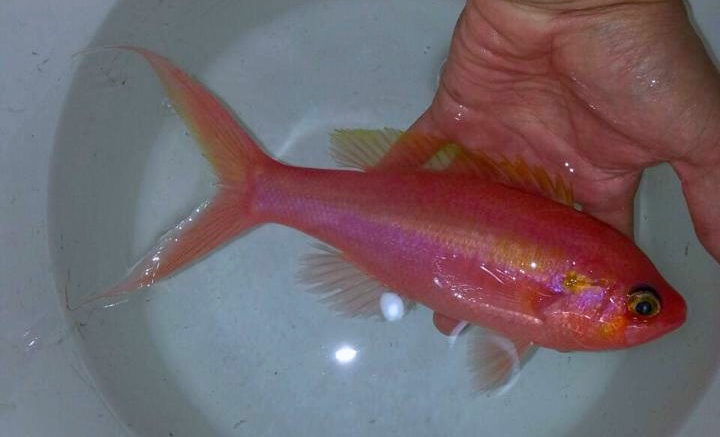Many deepwater reef fish don’t get enough air time simply because they live so deep and are hard to find. One such fish is Symphysanodon katayamai, or the yellow striped slopefish. Symphysanodon is a genus comprising of about a dozen species, all of which are deep swelling fish capable of growing to large bulky sizes. While many are never seen and with many more unknown species waiting to be described, a few do occasionally make their way to the aquarium trade. S. katayamai is one of them.

Of the many species of slopefishes, only two are infrequently seen. Symphysanodon katayamai is a large salmon pink species characterised by a horizontal yellow stripe running equatorially across the body. They possess long tapering tails which when included in overall length, can reach up to twenty centimetres. Like all members of the genus, S. katayamai is deep dwelling, and is often found in considerable depths up to 600ft.
Because of this they are hardly ever collected, and also because their large size doesn’t quite fit the usual reef fish profile that many aquarists come to know and love. They are however, really beautiful and can do very well in large set ups barring any collection complication. The individual above is a recent one collected in Taiwan, and exported to Hao Hoi aquarium in Hong Kong.
Symphysanodon katayamai has a large range, and is found in Indonesia, Japan, Taiwan up to Palau and even Hawaii. Not much is known, and there are a handful of undescribed species yet to be named. Luiz Rocha and his team collected a potentially undescribed species from Philippines, and Robert Whitton photographed a possible undescribed one in Hawaii as well.

An even deeper dwelling species is S. typus, which can be differentiated from S. katayamai by having its lower caudal lobe coloured yellow. S. typus can be found in excess of 1300 ft, and is frequently caught in trawler nets and line fishing. Live specimens are few and far between and like S. katayamai, can be hardy provided they do not suffer from decompression related injuries.
A very grainy video of S. typus can be seen above by DeepSeaChallengers. Big and beautiful, these deepwater fish require large set ups with unobstructed swimming areas, They would make excellent specimens for deepwater style biotopes in public aquariums, where they can be housed with species requiring similar habitats such as those from the genera Sacura, Liopropoma, Caprodon, Callanthias and Odontanthias. Just to name a few.



